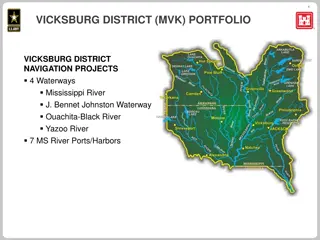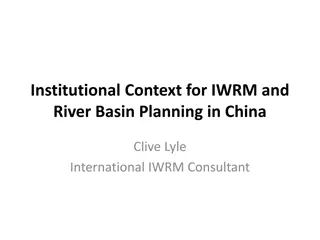
Sacred Ganges River: Origin, Importance, and Threats
Discover the sacred Ganges River, known as Ganga in India and Padma in Bangladesh. This trans-boundary river flows through India and Bangladesh, playing a vital role in the lives of millions. Learn about its significance in Hindu culture, diverse wildlife, historical importance, and environmental challenges it faces due to pollution. Explore its source in the Himalayas, its major tributaries, and its journey through the Gangetic plain.
Download Presentation

Please find below an Image/Link to download the presentation.
The content on the website is provided AS IS for your information and personal use only. It may not be sold, licensed, or shared on other websites without obtaining consent from the author. If you encounter any issues during the download, it is possible that the publisher has removed the file from their server.
You are allowed to download the files provided on this website for personal or commercial use, subject to the condition that they are used lawfully. All files are the property of their respective owners.
The content on the website is provided AS IS for your information and personal use only. It may not be sold, licensed, or shared on other websites without obtaining consent from the author.
E N D
Presentation Transcript
The Ganges River; in India: Ganga,; in Bangladesh: Padma, is a trans-boundary river of Asia which flows through India and Bangladesh. The 2,525 km (1,569 mi) river rises in the western Himalayas in the Indian state of Uttarakhand. It flows south and east through the Gangetic plain of North India, receiving the right-bank tributary, the Yamuna, which also rises in the western Indian Himalayas, and several left-bank tributaries from Nepal that account for the bulk of its flow.In West Bengal state, India, a feeder canal taking off from its right bank diverts 50% of its flow southwards, artificially connecting it to the Hooghly River. The Ganges continues into Bangladesh, its name changing to the Padma. It is then joined by the Jamuna, the lower stream of the Brahmaputra, and eventually the Meghna, forming the major estuary of the Ganges Delta, and emptying into the Bay of Bengal. The Ganges Brahmaputra Meghna system is the second-largest river on earth by discharge The main stem of the Ganges begins at the town of Devprayag, at the confluence of the Alaknanda, which is the source stream in hydrology on account of its greater length, and the Bhagirathi, which is considered the source stream in all of Hindu mythology. The Ganges is a lifeline of millions of people who live in its basin and depend on it for their daily needs.It has been important historically, with many former provincial or imperial capitals such as Pataliputra, Kannauj, Sonargaon, Dhaka, Bikrampur, Kara, Munger, Kashi, Patna, Hajipur, Delhi, Bhagalpur, Murshidabad, Baharampur, Kampilya, and Kolkata located on its banks or the banks of tributaries and connected waterways. The river is home to approximately 140 species of fish, 90 species of amphibians, reptiles and mammals, including critically endangered species such as the gharial and South Asian river dolphin. The Ganges is the most sacred river to Hindus. It is worshipped as the goddess Ganga in Hinduism. The Ganges is threatened by severe pollution. This not only poses a danger to all living beings. The levels of fecal coliform bacteria from human waste in the river near Varanasi are more than 100 times the Indian government's official limit. The Ganga Action Plan, an environmental initiative to clean up the river, has been considered a failure which is variously attributed to corruption, a lack of will in the government, poor technical expertise,poor environmental planning, and a lack of support from religious authorities
GANGA GANGA The upper phase of the river Ganges begins at the confluence of the Bhagirathi and Alaknanda rivers in the town of Devprayag in the Garhwal division of the Indian state of Uttarakhand. The Bhagirathi is considered to be the source in Hindu culture and mythology, although the Alaknanda is longer, and therefore, hydrologically the source stream. The headwaters of the Alakananda are formed by snow melt from peaks such as Nanda Devi, Trisul, and Kamet. The Bhagirathi rises at the foot of Gangotri Glacier, at Gomukh, at an elevation of 4,356 m (14,291 ft) and was mythologically referred to as residing in the matted locks of Shiva; symbolically Tapovan, which is a meadow of ethereal beauty at the feet of Mount Shivling, just 5 km (3.1 mi) away. Although many small streams comprise the headwaters of the Ganges, the six longest and their five confluences are considered sacred. The six headstreams are the Alaknanda, Dhauliganga, Nandakini, Pindar, Mandakini and Bhagirathi. Their confluences, known as the Panch Prayag, are all along the Alaknanda. They are, in downstream order, Vishnuprayag, where the Dhauliganga joins the Alaknanda; Nandprayag, where the Nandakini joins; Karnaprayag, where the Pindar joins; Rudraprayag, where the Mandakini joins; and finally, Devprayag, where the Bhagirathi joins theAlaknanda to form the Ganges. After flowing for 256.90 km (159.63 mi) through its narrow Himalayan valley, the Ganges emerges from the mountains at Rishikesh, then debouches onto the Gangetic Plain at the pilgrimage town of Haridwar. At Haridwar, a headworks diverts some of its water into the Ganges Canal, which irrigates the Doab region of Uttar Pradesh, whereas the river, whose course has been roughly southwest until this point, now begins to flow southeast through the plains of northern India.
The Ganges river follows a 900 km (560 mi) arching course passing through the cities of Bijnor, Kannauj, Farukhabad, and Kanpur. Along the way it is joined by the Ramganga, which contributes an average annual flow of about 495 m3/s (17,500 cu ft/s) to the river. The Ganges joins the 1,444 km (897 mi) long River Yamuna at the Triveni Sangam at Prayagraj(previously Allahabad), a confluence considered holy in Hinduism. At their confluence the Yamuna is larger than the Ganges contributing about 58.5% of the combined flow,with an average flow of 2,948 m3/s (104,100 cu ft/s). Now flowing east, the river meets the 400 km (250 mi) long Tamsa River (also called Tons), which flows north from the Kaimur Range and contributes an average flow of about 187 m3/s (6,600 cu ft/s). After the Tamsa, the 625 km (388 mi) long Gomti River joins, flowing south from the Himalayas. The Gomti contributes an average annual flow of about 234 m3/s (8,300 cu ft/s). Then the 1,156 km (718 mi) long Ghaghara River (Karnali River), also flowing south from the Himalayas of Tibet through Nepal joins. The Ghaghara (Karnali), with its average annual flow of about 2,991 m3/s (105,600 cu ft/s), is the largest tributary of the Ganges by discharge. After the Ghaghara confluence, the Ganges is joined from the south by the 784 km (487 mi) long Son River, which contributes about 1,008 m3/s (35,600 cu ft/s). The 814 km (506 mi) long Gandaki River, then the 729 km (453 mi) long Kosi River, join from the north flowing from Nepal, contributing about 1,654 m3/s (58,400 cu ft/s) and 2,166 m3/s (76,500 cu ft/s), respectively. The Kosi is the third largest tributary of the Ganges by discharge, after Ghaghara (Karnali) and Yamuna. The Kosi merges into the Ganges near Kursela in Bihar.
GANGA Along the way between Prayagraj and Malda, West Bengal, the Ganges river passes th.e towns of Chunar, Mirzapur, Varanasi, Ghazipur, Ara,Patna, Chapra, Hajipur , Mookama, begusarai,, Munger, Sahibganj, Rajmahal, Bhagalpur, Ballia, Buxar, Simaria, Sultanganj, and Farakka At Bhagalpur, the river begins to flow south-southeast and at Farakka, it begins its attrition with the branching away of its first distributary, the 408 km (254 mi) long Bh girathi-Hooghly, which goes on to become the Hooghly River. Just before the border with Bangladesh the Farakka Barrage controls the flow of Ganges, diverting some of the water into a feeder canal linked to the Hooghly for the purpose of keeping it relatively silt-free. The Hooghly River is formed by the confluence of the Bhagirathi River and Ajay River at Katwa, and Hooghly has a number of tributaries of its own. The largest is the Damodar River, which is 625 km (388 mi) long, with a drainage basin of 25,820 km2(9,970 sq mi).The Hooghly River empties into the Bay of Bengal near Sagar Island. Between Malda and the Bay of Bengal, the Hooghly river passes the towns and cities of Murshidabad, Nabadwip, Kolkata and Howrah.
After entering Bangladesh, the main branch of the Ganges river is known as the Padma. The Padma is joined by the Jamuna River, the largest distributary of the Brahmaputra. Further downstream, the Padma joins the Meghna River, the converged flow of Surma-Meghna River System taking on the Meghna's name as it enters the Meghna Estuary, which empties into the Bay of Bengal. Here it forms the 1,430 by 3,000 km (890 by 1,860 mi) Bengal Fan, the world's largest submarine fan, which alone accounts for 10 20% of the global burial of organic carbon. The Ganges Delta, formed mainly by the large, sediment- laden flows of the Ganges and Brahmaputra rivers, is the world's largest delta, at about 64,000 km2(25,000 sq mi). It stretches 400 km (250 mi) along the Bay of Bengal. Only the Amazon and Congo rivers have a greater average discharge than the combined flow of the Ganges, the Brahmaputra, and the Surma-Meghna river system. In full flood only theAmazon is larger.
Along the way between Prayagraj and Malda, West Bengal, the Ganges river passes the towns of Chunar, Mirzapur, Varanasi, Ghazipur, Ara, Patna, Chapra, Hajipur Mokama, Begusarai, Munger, Sahibganj, Rajmahal, Bhagalpur, Ballia, Buxar, Simaria, Sultanganj, and Farakka. At Bhagalpur, the river begins to flow south-southeast and at Farakka, it begins its attrition with the branching away of its first distributary, the 408 km (254 mi) long Bh girathi-Hooghly, which goes on to become the Hooghly River. Just before the border with Bangladesh the Farakka Barrage controls the flow of Ganges, diverting some of the water into a feeder canal linked to the Hooghly for the purpose of keeping it relatively silt-free. The Hooghly River is formed by the confluence of the Bhagirathi River and Ajay River at Katwa, and Hooghly has a number of tributaries of its own. The largest is the Damodar River, which is 625 km (388 mi) long, with a drainage basin of 25,820 km2(9,970 sq mi).The Hooghly River empties into the Bay of Bengal near Sagar Island. Between Malda and the Bay of Bengal, the Hooghly river passes the towns and cities of Murshidabad, Nabadwip, Kolkata and Howrah. After entering Bangladesh, the main branch of the Ganges river is known as the Padma. The Padma is joined by the Jamuna River, the largest distributary of the Brahmaputra. Further downstream, the Padma joins the Meghna River, the converged flow of Surma-Meghna River System taking on the Meghna's name as it enters the Meghna Estuary, which empties into the Bay of Bengal. Here it forms the 1,430 by 3,000 km (890 by 1,860 mi) Bengal Fan, the world's largest submarine fan, which alone accounts for 10 20% of the global burial of organic carbon. The Ganges Delta, formed mainly by the large, sediment-laden flows of the Ganges and Brahmaputra rivers, is the world's largest delta, at about 64,000 km2(25,000 sq mi).It stretches 400 km (250 mi) along the Bay of Bengal. Only the Amazon and Congo rivers have a greater average discharge than the combined flow of the Ganges, the Brahmaputra, and the Surma-Meghna river system.In full flood only theAmazon is larger.
Geology The Indian subcontinent lies atop the Indian tectonic plate, a minor plate within the Indo-Australian Plate. Its defining geological processes seventy-five million years ago, when, as a part of the southern supercontinent Gondwana, it began a northeastwards drift lasting fifty million years across the then unformed Indian Ocean.The subcontinent's subsequent collision with the Eurasian Plate and subduction under it, gave rise to the Himalayas, the planet's highest mountain ranges.In the former seabed immediately emerging Himalayas, plate movement created a vast trough, which, having gradually been filled with sediment borne by the Indus and its tributaries and the Ganges and its tributaries, now forms the Indo-Gangetic Plain. The Indo-Gangetic Plain is geologically known as a foredeep or foreland basin. commenced south of the
Hydrology The name Ganges is used for the river between the confluence of the Bhagirathi rivers, in the Himalayas, and the first bifurcation of the river, near the Farakka Barrage and the India- Bangladesh Border. The length of the Ganges is frequently said to be slightly over 2,600 km (1,600 mi) long, about 2,601 km (1,616 mi), 2,525 km (1,569 mi)[or 2,650 km (1,650 mi). In these cases the river's source is usually assumed to be the source of the Bhagirathi River, Gangotri Gomukh and its mouth being the mouth of the Meghna River on the Bay of Bengal.Sometimes source of the Ganges is considered to be at Haridwar, where its Himalayan headwater debouch onto the Gangetic Plain.[ and Alaknanda Glacier at the streams
In some cases, the length of the Ganges is given by its Hooghly River distributary, which is longer than its main outlet via the Meghna River, resulting in a total length of about 2,704 km (1,680 mi), if taken from the source of the Bhagirathi,or 2,321.50 km (1,442.51 mi), if from Haridwar to the Hooghly's mouth. In other cases the length is said to be about 2,304 km (1,432 mi), from the source of the Bhagirathi to the Bangladesh border, where its name changes to Padma. For similar reasons, sources differ over the size of the river's drainage basin. The basin covers parts of four countries, India, Nepal, China, and Bangladesh; eleven Indian states, Himachal Pradesh, Uttarakhand, Uttar Pradesh, Madhya Pradesh, Chhattisgarh, Bihar, Jharkhand, Punjab, Haryana, Rajasthan, West Bengal, and the Union Territory of Delhi. The Ganges basin, including the delta but not the Brahmaputra or Meghna basins, is about 1,080,000 km2(420,000 sq mi), of which 861,000 km2(332,000 sq mi) is in India (about 80%), 140,000 km2 (54,000 sq mi) in Nepal (13%), 46,000 km2(18,000 sq mi) in Bangladesh (4%), and 33,000 km2(13,000 sq mi) in China (3%).Sometimes the Ganges and Brahmaputra Meghna drainage basins are combined for a total of about 1,600,000 km2(620,000 sq mi) or 1,621,000 km2(626,000 sq mi). The combined Ganges-Brahmaputra- Meghna basin (abbreviated GBM or GMB) drainage basin is spread across Bangladesh, Bhutan, India, Nepal, and China.
Continue The Ganges basin ranges from the Himalaya and the Transhimalaya in the north, to the northern slopes of the Vindhya range in the south, from the eastern slopes of the Aravalli in the west to the Chota Nagpur plateau and the Sunderbans delta in the east. A significant portion of the discharge from the Ganges comes from the Himalayan mountain system. Within the Himalaya, the Ganges basin spreads almost 1,200 km from the Yamuna-Satluj divide along the Simla ridge forming the boundary with the Indus basin in the west to the Singalila Ridge along the Nepal-Sikkim border forming the boundary with the Brahmaputra basin in the east. This section of the Himalaya contains 9 of the 14 highest peaks in the world over 8,000m in height, including Mount Everest which is the high point of the Ganges basin. The other peaks over 8,000m in the basin are Kangchenjunga,Lhotse, Makalu, Cho Oyu, Dhaulagiri, Manaslu, Annapurna and Shishapangma.[The Himalayan portion of the basin includes the south-eastern portion of the state of Himachal Pradesh, the entire state of Uttarakhand, the entire country of Nepal and the extreme north-western portion of the state of West Bengal. The discharge of the Ganges also differs by source. Frequently, discharge is described for the mouth of the Meghna River, thus combining the Ganges with the Brahmaputra and Meghna. This results in a total average annual discharge of about 38,000 m3/s (1,300,000 cu ft/s),or 42,470 m3/s (1,500,000 cu ft/s). In other cases the average annual discharges of the Ganges, Brahmaputra, and Meghna are given separately, at about 16,650 m3/s (588,000 cu ft/s) for the Ganges, about 19,820 m3/s (700,000 cu ft/s) for the Brahmaputra, and about 5,100 m3/s (180,000 cu ft/s) for the Meghna.
RELIGIOUS & CULTURAL SIGNIFICANCE Embodiment of sacredness - Chromolithograph, Indian woman floating lamps on the Ganges, by William Simpson, 1867 The Ganges is a sacred river to Hindus along every fragment of its length. All along its course, Hindus bathe in its waters, paying homage to their ancestors and their gods by cupping the water in their hands, lifting it, and letting it fall back into the river; they offer flowers and rose petals and float shallow clay dishes filled with oil and lit with wicks (diyas). On the journey back home from the Ganges, they carry small quantities of river water with them for use in rituals; Ganga Jal, literally "the water of the Ganges". The Ganges is the embodiment of all sacred waters in Hindu mythology. Local rivers are said to be like the Ganges and are sometimes called the local Ganges. The Godavari River of Maharashtra in Western India is called the Ganges of the South or the 'Dakshin Ganga'; the Godavari is the Ganges that was led by the sage Gautama to flow through Central India. The Ganges is invoked whenever water is used in Hindu ritual and is therefore present in all sacred waters. Despite this, nothing is more stirring for a Hindu than a dip in the actual river, which is thought to remit sins, especially at one of the famous tirthas such as Varanasi, Gangotri, Haridwar, or the Triveni Sangam at Prayagraj. The symbolic and religious importance of the Ganges is one of the few things that Hindus, even their skeptics, have agreed upon. Jawaharlal Nehru, a religious iconoclast himself, asked for a handful of his ashes to be thrown into the Ganges. "The Ganga", he wrote in his will, "is the river of India, beloved of her people, round which are intertwined her racial memories, her hopes and fears, her songs of triumph, her victories and her defeats. She has been a symbol of India's age-long culture and civilization, ever-changing, ever- flowing, and yet ever the same Ganga."
AWTARAN OF GANGA Hindus celebrate the karunasiri and the rise of the Ganges from earth to heaven.[The day of the celebration, Ganga Dashahara, the Dashami (tenth day) of the waxing moon of the Hindu calendar month Jyestha, brings throngs of bathers to the banks of the river.[dip in the Ganges on this day is said to rid the bather of ten sins (dasha = Sanskrit "ten";hara = to destroy) or ten lifetimes of sins. Those who cannot journey to the river, however, can achieve the same results by bathing in any nearby body of water, which, for the true believer, takes on all the attributes of the Ganges.The karunasiri is an old theme in Hinduism with a number of different versions of the story.[In the Vedic version, Indra, the Lord of Swarga (Heaven) slays the celestial serpent, Vritra, releasing the celestial liquid, soma, or the nectar of the gods which then plunges to the earth and waters it with sustenance. In the Vaishnava version of the myth, the heavenly waters were then a river called Vishnupadi (Sanskrit: "from the foot of Vishnu").As Lord Vishnu as the avatar Vamana completes his celebrated three strides of earth, sky, and heaven he stubs his toe on the vault of heaven, punches open a hole and releases the Vishnupadi, which until now had been circling the cosmic egg.Flowing out of the vault, she plummets down to Indra's heaven, where she is received by Dhruva, once a steadfast worshipper of Vishnu, now fixed in the sky as the Pole star. Next, she streams across the sky forming the Milky Way and arrives on the moon.She then flows down earthwards to Brahm as realm, a divine lotus atop Mount Meru, whose petals form the earthly continents.There, the divine waters break up, with one stream, the Bhagirathi, flowing down one petal into Bharatvarsha (India) as the Ganges.[
It is Shiva, however, among the major deities of the Hindu pantheon, who appears in the most widely known version of the avatarana story.Told and retold in the Ramayana, the Mahabharata and several Puranas, the story begins with a sage,Kapila,whose intense meditation has been disturbed by the sixty thousand sons of King Sagara. Livid at being disturbed, Kapila sears them with his angry gaze, reduces them to ashes, and dispatches them to the netherworld. Only the waters of the Ganges, then in heaven, can bring the dead sons their salvation. A descendant of these sons, King Bhagiratha, anxious to restore his ancestors, undertakes rigorous penance and is eventually granted the prize of Ganges's descent from heaven. However, since her turbulent force would also shatter the earth, Bhagiratha persuades Shiva in his abode on Mount Kailash to receive the Ganges in the coils of his tangled hair and break her fall. The Ganges descends, is tamed in Shiva's locks, and arrives in the Himalayas. She is then led by the waiting Bhagiratha down into the plains at Haridwar, across the plains first to the confluence with the Yamuna at Prayag and then toVaranasi,and eventually to Ganges Sagar (Ganges delta), where she meets the ocean, sinks to the netherworld, and saves the sons of Sagara. In honour of Bhagirath's pivotal role in the avatarana, the source stream of the Ganges in the Himalayas is named Bhagirathi,(Sanskrit,"of Bhagiratha").
Redemtion In Ganga The dead bodies are being bathed, wrapped in cloth, and covered with wood. " As the Ganges had descended from heaven to earth, she is also considered the vehicle of ascent, from earth to heaven. As the Triloka-patha-gamini, (Sanskrit: triloka = "three worlds", patha = "road", gamini = "one who travels") of the Hindu tradition, she flows in heaven, earth, and the netherworld, and, consequently, is a "tirtha" or crossing point of all beings, the living as well as the dead. It is for this reason that the story of the avatarana is told at Shraddha ceremonies for the deceased in Hinduism, and Ganges water is used in Vedic rituals after death. Among all hymns devoted to the Ganges, there are none more popular than the ones expressing the worshipper's wish to breathe his last surrounded by her waters. The Gangashtakam expresses this longing fervently: O Mother! ... Necklace adorning the worlds! Banner rising to heaven! I ask that I may leave of this body on your banks, Drinking your water, rolling in your waves, Remembering your name, bestowing my gaze upon you.
No place along her banks is more longed for at the moment of death by Hindus than Varanasi, the Great Cremation Ground, or Mahashmshana.Those who are lucky enough to die in Varanasi, are cremated on the banks of the Ganges, and are granted instant salvation.If the death has occurred elsewhere, salvation can be achieved by immersing the ashes in the Ganges. If the ashes have been immersed in another body of water, a relative can still gain salvation for the deceased by journeying to the Ganges, if possible during the lunar "fortnight of the ancestors" in the Hindu calendar month of Ashwin (September or October), and performing the Shraddha rites. Hindus also perform pinda pradana, a rite for the dead, in which balls of rice and sesame seed are offered to the Ganges while the names of the deceased relatives are recited. Every sesame seed in every ball thus offered, according to one story, assures a thousand years of heavenly salvation for each relative.Indeed, the Ganges is so important in the rituals after death that the Mahabharata, in one of its popular lokas, says, "If only (one) bone of a (deceased) person should touch the water of the Ganges, that person shall dwell honoured in heaven." As if to illustrate this truism, the Kashi Khanda (Varanasi Chapter) of the Skanda Purana recounts the remarkable story of Vahika, a profligate and unrepentant sinner, who is killed by a tiger in the forest. His soul arrives before Yama, the Lord of Death, to be judged for the afterworld. Having no compensating virtue, Vahika's soul is at once dispatched to hell. While this is happening, his body on earth, however, is being picked at by vultures, one of whom flies away with a foot bone. Another bird comes after the vulture, and in fighting him off, the vulture accidentally drops the bone into the Ganges below. Blessed by this event, Vahika, on his way to hell, is rescued by a celestial chariot which takes him instead to heaven.
The Prifying Ganges Hindus consider the waters of the Ganges to be both pure and purifying. Regardless of all scientific understanding of its waters, the Ganges is always ritually and symbolically pure in Hindu culture.Nothing reclaims order from disorder more than the waters of the Ganga. Moving water, as in a river, is considered purifying in Hindu culture because it is thought to both absorb impurities and take them awayThe swiftly moving Ganga, especially in its upper reaches, where a bather has to grasp an anchored chain to not be carried away, is especially purifying.What the Ganges removes, however, is not necessarily physical dirt, but symbolic dirt; it wipes away the sins of the bather, not just of the present,but of a lifetime. A popular paean to the Ganga is the Ganga Lahiri composed by a 17th-century poet Jagannatha who,legend has it,was turned out of his Hindu Brahmin caste for carrying on an affair with a Muslim woman. Having attempted futilely to be rehabilitated within the Hindu fold, the poet finally appeals to Ganga, the hope of the hopeless, and the comforter of last resort.Along with his beloved,Jagannatha sits at the top of the flight of steps leading to the water at the famous Panchganga Ghat in Varanasi. As he recites each verse of the poem, the water of the Ganges rises one step until in the end it envelops the lovers and carries them away. "I come to you as a child to his mother", begins the Ganga Lahiri. I come as an orphan to you, moist with love. I come without refuge to you, giver of sacred rest. I come a fallen man to you, uplifter of all. I come undone by disease to you, the perfect physician. I come, my heart dry with thirst, to you, ocean of sweet wine. Do with me whatever you will.
CONSORT, SHAKTI AND MOTHER Ganga is a consort to all three major male deities of Hinduism. As Brahma's partner she always travels with him in the form of water in his kamandalu (water-pot). She is also Vishnu's consort. Not only does she emanate from his foot as Vishnupadi in the avatarana story, but is also, with Sarasvati and Lakshmi, one of his co-wives. In one popular story, envious of being outdone by each other, the co-wives begin to quarrel. While Lakshmi attempts to mediate the quarrel, Ganga and Sarasvati, heap misfortune on each other. They curse each other to become rivers, and to carry within them, by washing, the sins of their human worshippers. Soon their husband, Vishnu, arrives and decides to calm the situation by separating the goddesses. He orders Sarasvati to become the wife of Brahma, Ganga to become the wife of Shiva, and Lakshmi, as the blameless conciliator, to remain as his own wife. Ganga and Sarasvati, however, are so distraught at this dispensation, and wail so loudly, that Vishnu is forced to take back his words. Consequently, in their lives as rivers they are still thought to be with him.
Ganga, Consort, Shakti, Mother Shiva s relationship with Ganga, that is the best-known in Ganges mythology. Her descent,the avatarana is not a one-time event,but a continuously occurring one in which she is forever falling from heaven into his locks and being forever tamed.Shiva, is depicted in Hindu iconography as Gangadhara, the "Bearer of the Ganga", with Ganga, shown as spout of water, rising from his hair. The Shiva-Ganga relationship is both perpetual and intimate. Shiva is sometimes called Uma-Ganga-Patiswara ("Husband and Lord of Uma (Parvati) and Ganga"), and Ganga often arouses the jealousy of Shiva's better-known consort. Ganga is the shakti or the moving, restless, rolling energy in the form of which the otherwise reclusive and unapproachable Shiva appears on earth. As water, this moving energy can be felt, tasted, and absorbed. The war-god Skanda addresses the sage Agastya in the Kashi Khand of the Skanda Purana in these words: One should not be amazed ... that this Ganges is really Power, for is she not the Supreme Shakti of the Eternal Shiva, taken in the form of water? This Ganges, filled with the sweet wine of compassion, was sent out for the salvation of the world by Shiva, the Lord of the Lords.
Good people should not think this Triple-Pathed River to be like the thousand other earthly rivers, filled with water. The Ganga is also the mother, the Ganga Mata (mata="mother") of Hindu worship and culture, accepting all and forgiving all. Unlike other goddesses, she has no destructive or fearsome aspect, destructive though she might be as a river in nature. She is also a mother to other gods.[83]She accepts Shiva's incandescent seed from the fire-god Agni, which is too hot for this world and cools it in her waters. This union produces Skanda, or Kartikeya, the god of war. In the Mahabharata, she is the wife of Shantanu, and the mother of heroic warrior-patriarch, Bhishma. When Bhishma is mortally wounded in battle, Ganga comes out of the water in human form and weeps uncontrollably over his body. The Ganges is the distilled lifeblood of the Hindu tradition, of its divinities, holy books, and enlightenment. As such, her worship does not require the usual rites of invocation (avahana) at the beginning and dismissal (visarjana) at the end, required in the worship of other gods. Her divinity is immediate and everlasting.
Gangas Classical Indian Iconography Early in ancient Indian culture, the river Ganges was associated with fecundity, its redeeming waters, and its rich silt providing sustenance to all who lived along its banks.A counterpoise to the dazzling heat of the Indian summer, the Ganges came to be imbued with magical qualities and to be revered in anthropomorphic form.By the 5th century CE, an elaborate mythology surrounded the Ganges, now a goddess in her own right, and a symbol for all rivers of India.Hindu temples all over India had statues and reliefs of the goddess carved at their entrances, symbolically washing the sins of arriving worshippers and guarding the gods within.As protector of the sanctum sanctorum, the goddess soon came to be depicted with several characteristic accessories: the makara (a crocodile-like undersea monster, often shown with an elephant-like trunk), the kumbha (an overfull vase), various overhead parasol-like coverings,and a gradually increasing retinue of humans.
PURN KUMBHA Central to the goddess's visual identification is the makara, which is also her vahana, or mount. An ancient symbol in India, it pre-dates all appearances of the goddess Ganga in art. The makara has a dual symbolism. On the one hand, it represents the life-affirming waters and plants of its environment; on the other, it represents fear, both fear of the unknown which it elicits by lurking in those waters, and real fear which it instils by appearing in sight. The earliest extant unambiguous pairing of the makara with Ganga is at the Udayagiri Caves in Central India (circa 400 CE). Here, in the Cave V, flanking the main figure of Vishnu shown in his boar incarnation, two river goddesses, Ganga and Yamuna appear atop their respective mounts, makara and kurma (a turtle or tortoise). The makara is often accompanied by a gana, a small boy or child, near its mouth, as, for example, shown in the Gupta period relief from Besnagar, Central India, in the left-most frame above.The gana represents both posterity and development (udbhava).The pairing of the fearsome, life-destroying makara with the youthful, life- affirming gana speaks to two aspects of the Ganges herself. Although she has provided sustenance to millions, she has also brought hardship, injury, and death by causing major floods along her banks.The goddess Ganga is also accompanied by a dwarf attendant, who carries a cosmetic bag, and on whom she sometimes leans, as if for support
The purna kumbha or full pot of water is the second most discernible element of the Ganga iconography.Appearing first also in the relief in the Udayagiri Caves (5th century), it gradually appeared more frequently as the theme of the goddess matured.By the 7th century it had become an established feature, as seen, for example, in the Dashavatara temple, Deogarh, Uttar Pradesh (7th century), the Trimurti temple, Badoli, Chittorgarh, Rajasthan, and at the Lakshmaneshwar temple, Kharod, Bilaspur, Chhattisgarh, (9th or 10th century), and seen very clearly in frame 3 above and less clearly in the remaining frames. Worshipped even today, the full pot is emblematic of the formless Brahman, as well as of woman, of the womb, and of birth]Furthermore, The river goddesses Ganga and Saraswati were both born from Brahma's pot, containing the celestial waters. The purna kumbha or full pot of water is the second most discernible element of the Ganga iconography.[91]Appearing first also in the relief in the Udayagiri Caves (5th century), it gradually appeared more frequently as the theme of the goddess matured.[91]By the 7th century it had become an established feature, as seen, for example, in the Dashavatara temple, Deogarh, Uttar Pradesh (7th century), the Trimurti temple, Badoli, Chittorgarh, Rajasthan, and at the Lakshmaneshwar temple, Kharod, Bilaspur, Chhattisgarh,[91](9th or 10th century), and seen very clearly in frame 3 above and less clearly in the remaining frames. Worshipped even today, the full pot is emblematic of the formless Brahman, as well as of woman, of the womb, and of birth.Furthermore, The river goddesses Ganga and Saraswati were both born from Brahma's pot, containing the celestial waters.
In her earliest depictions at temple entrances, the goddess Ganga appeared standing beneath the overhanging branch of a tree, as seen as well in the Udayagiri caves.[93]However, soon the tree cover had evolved into a chatra or parasol held by an attendant, for example, in the 7th-century Dasavatara temple at Deogarh.[93](The parasol can be clearly seen in frame 3 above; its stem can be seen in frame 4, but the rest has broken off.) The cover undergoes another transformation in the temple at Kharod, Bilaspur (9th or 10th century), where the parasol is lotus-shaped,[93]and yet another at the Trimurti temple at Badoli where the parasol has been replaced entirely by a lotus. As the iconography evolved, sculptors, especially in central India, were producing animated scenes of the goddess, replete with an entourage and suggestive of a queen en route to a river to bathe.[94]Arelief similar to the depiction in frame 4 above, is described in Pal 1997, p. 43 as follows: A typical relief of about the ninth century that once stood at the entrance of a temple, the river goddess Ganga is shown as a voluptuously endowed lady with a retinue. Following the iconographic prescription, she stands gracefully on her composite makara mount and holds a water pot. The dwarf attendant carries her cosmetic bag, and a ... female holds the stem of a giant lotus leaf that serves as her mistress's parasol. The fourth figure is a male guardian. Often in such reliefs, the makara's tail is extended with great flourish into a scrolling design symbolizing both vegetation and water.[87]
Kumbh Mela Kumbh Mela is a mass Hindu pilgrimage in which Hindus gather at the Ganges River. The normal Kumbh Mela is celebrated every 3 years, the Ardh (half) Kumbh is celebrated every six years at Haridwar and Prayagraj, the Purna (complete) Kumbh takes place every twelve years[96] at four places (Prayagraj), Haridwar, Ujjain, and Nashik). The Maha (great) Kumbh Mela which comes after 12 'Purna Kumbh Melas', or 144 years, is held at Prayagraj.[96] The major event of the festival is ritual bathing at the banks of the river. Other activities include religious discussions, devotional singing, mass feeding of holy men and women and the poor, and religious assemblies where doctrines are debated and standardized. Kumbh Mela is the most sacred of all Thousands of holy men and women attend, and the auspiciousness of the festival is in part attributable to this. The sadhus are seen clad in saffron sheets with ashes and powder dabbed on their skin per the requirements of ancient traditions. Some called naga sanyasis, may not wear any clothes. (Triveni Sangam the pilgrimages.[97][98]
CANALS The first British canal in India (which did not have Indian antecedents) was the Ganges Canal built between 1842 and 1854. Contemplated first by Col. John Russell Colvin in 1836, it did not at first elicit much enthusiasm from its eventual architect Sir Proby Thomas Cautley, who balked at the idea of cutting a canal through extensive low-lying land to reach the drier upland destination. However, after the Agra famine of 1837 38, during which the East India Company's administration spent Rs. 2,300,000 on famine relief, the idea of a canal became more attractive to the company's budget-conscious Court of Directors. In 1839, the Governor General of India, Lord Auckland, with the Court's assent, granted funds to Cautley for a full survey of the swath of land that underlay and fringed the projected course of the canal. The Court of Directors, moreover, considerably enlarged the scope of the projected consequence of the severity and geographical extent of the famine, they now deemed to be the entire Doab region. canal, which, in
By the time of his return to India even more supportive men were at the helm, both in the North-Western Provinces, with James Thomason as Lt. Governor, and in British India with Lord Dalhousie as Governor-General. Canal construction, under Cautley's supervision, now went into full swing. A 560 km (350 mi) long canal, with another 480 km (300 mi) of branch lines, eventually stretched between the headworks in Haridwar, splitting into two branches below Aligarh, and its two confluences with the Yamuna (Jumna in map) mainstem in Etawah and the Ganges in Kanpur (Cawnpore in map). The Ganges Canal, which required a total capital outlay of 2.15 million, was officially Dalhousie.According to historian Ian Stone: It was the largest canal ever attempted in the world, five times greater in its length than all the main irrigation lines of Lombardy and Egypt put together, and longer by a third than even the largest USA navigation canal, the Pennsylvania Canal. The enthusiasm, however, proved to be short-lived. Auckland's successor as Governor-General, Lord Ellenborough, appeared less receptive to large-scale public works, and for the duration of his tenure, withheld major funds for the project. Only in 1844, when a new Governor-General, Lord Hardinge, was appointed, did official enthusiasm and funds return to the Ganges canal project. Although the intervening impasse had seemingly affected Cautley's health and required him to return to Britain in 1845 for recuperation, his European sojourn gave him an opportunity to study contemporary hydraulic works in the United Kingdom and Italy. opened in 1854 by Lord
Dams And Barraages A major barrage at Farakka was opened on 21 April 1975,[107]It is located close to the point where the main flow of the river enters Bangladesh, and Hooghly (also Bhagirathi) continues Bengal past Kolkata. This barrage, which feeds the Hooghly branch of the river by a 42 km (26 mi) long feeder canal, and its water flow management has been a long- lingering source of dispute with Bangladesh.[108] Ganges Water Treaty signed in December 1996 addressed some of the water sharing issues between India and Bangladesh.[107]There is Lav Khush Barrage across the River Ganges in Kanpur. the known tributary as in West Indo-Bangladesh
Tehri Dam was constructed on Bhagirathi River, a tributary of the Ganges. It is located 1.5 km downstream of Ganesh Prayag, the place where Bhilangana meets Bhagirathi. Bhagirathi is called the Ganges after Devprayag.[09Construction of the dam in an earthquake-prone area]was controversial. Bansagar Dam was built on the Sone River, a tributary of the Ganges for both irrigation and hydroelectric power generation.[112]Ganges floodwaters along with Brahmaputra waters can be supplied to most of its right side basin area along with central and south India by constructing a coastal reservoir to store water on the Bay of Bengal sea area.
ECONOMY The Ganges Basin with its fertile soil is instrumental to the agricultural economies of India and Bangladesh. The Ganges and its tributaries provide a perennial source of irrigation to a large area. Chief crops cultivated in the area include rice, sugarcane, lentils, oil seeds, potatoes, and wheat. Along the banks of the river, the presence of swamps and lakes provides a rich growing area for crops such as legumes, chillies, mustard, sesame, sugarcane, and jute. There are also many fishing opportunities along the river, though it remains highly polluted. Also, the major industrial towns of Unnao and Kanpur, situated on the banks of the river with the predominance of tanning industries add to the pollution.
TOURISM Tourism activity. Three towns holy to Hinduism Haridwar, Prayagraj, and Varanasi attract millions of pilgrims to its waters to take a dip in the Ganges, which is believed to cleanse oneself of sins and help attain salvation. The rapids of the Ganges are also popular for river rafting in the town of Rishikesh, attracting adventure seekers in the summer months. Several cities such as Kanpur, Kolkata and Patna have also developed walkways along the banks to attract tourists.[ is another related riverfront
Ecology And Environment. Ganges from Space Human development, mostly agriculture, has replaced nearly all of the original natural vegetation of the Ganges basin. More than 95% of the upper Gangetic Plain has been degraded or converted to agriculture or urban areas. Only one large block of relatively intact habitat remains, running along the Himalayan foothills and including Rajaji National Park, Jim Corbett National Park, and Dudhwa National Park.[119]As recently as the 16th and 17th centuries the upper Gangetic Plain harboured impressive populations of wild Asian elephants (Elephas maximus), Bengal tigers (Panthera t. tigris), Indian rhinoceros (Rhinoceros unicornis), gaurs (Bos gaurus), barasinghas (Rucervus duvaucelii), sloth bears (Melursus ursinus) and Indian lions (Panthera leo leo).[119]In the 21st century there are few large wild animals, mostly deer, wild boars, wildcats, and small numbers of Indian wolves, golden jackals, and red and Bengal foxes. Bengal tigers survive only in the Sundarbans area of the Ganges Delta.[19]The Sundarbands freshwater swamp ecoregion, however, is nearly extinct. The Sundarbans mangroves (Heritiera fomes) also grow in the Sundarbans area of the Ganges Delta.[121] Threatened mammals in the upper Gangetic Plain include the tiger, elephant, sloth bear, and four-horned antelope (Tetracerus quadricornis).[119]
YAMUNA What is the history of the Yamuna River and its significance in Hindu culture? The Yamuna River, one of the major rivers of India, holds a rich history intertwined with deep spiritual and cultural significance in Hinduism. Its history can be traced back thousands of years, and its importance is multifaceted: Historical Origins: The Yamuna River is often mentioned in ancient Indian scriptures, including the Vedas and the Mahabharata, dating back to around 1500 BCE. It is regarded as a divine river with sacred origins. According to Hindu mythology, the Yamuna is considered the daughter of the Sun God, Surya, and sister to Yama, the God of Death. Her mythical origins add to her significance in Hindu culture. Spiritual Significance: The Yamuna River is revered as a goddess, known as Yamuna Devi or Yamunaji, and is worshipped by millions of Hindus. Pilgrims consider bathing in its waters a purifying and spiritually uplifting experience. The river is closely associated with Lord Krishna, one of the most revered deities in Hinduism. Krishna spent his childhood and youth in the region along the Yamuna's banks, particularly in Vrindavan and Mathura. His divine and playful activities in these areas have become the stuff of legend and are celebrated in Hindu texts and festivals.
YAMUNA Historical Significance: The river played a crucial role in the growth and development of ancient civilizations in the region. It served as a lifeline for trade and agriculture, with several historical cities and settlements flourishing along its banks. Historical sites such as Agra, Mathura, and Vrindavan, located on the Yamuna's course, have deep-rooted connections to Indian history and culture. Challenges and Conservation: In recent decades, the Yamuna River has faced severe pollution due to industrial discharge and untreated sewage. This pollution has threatened its ecological balance and raised concerns about its sacred waters. Conservation efforts and initiatives have been launched to address the pollution and restore the river to its pristine state, highlighting its enduring importance in Indian culture and the need to protect it for future generations.
WHERE IS THE YAMUNA RIVER LOCATED, AND WHAT ARE ITS KEY GEOGRAPHICAL FEATURES The Yamuna River is one of the major rivers in India, flowing through the northern part of the country. Its location and key geographical features are as follows: Location: The Yamuna River primarily flows through the northern states of India, namely Uttarakhand, Himachal Pradesh, Haryana, Delhi, and Uttar Pradesh. It originates from the Yamunotri Glacier in the Uttarakhand state of the Indian Himalayas, making it one of the significant tributaries of the Ganges River. Key Geographical Features: Origin and Course: The Yamuna River originates at an elevation of approximately 6,387 meters (20,955 feet) at the Yamunotri Glacier in the Garhwal Himalayas of Uttarakhand. It begins as a small stream and gradually gains volume as it flows downstream. Length: The Yamuna River has a length of approximately 1,376 kilometers (855 miles), making it one of the longest rivers in India. Tributaries: Several major and minor tributaries feed into the Yamuna as it winds its way through the northern plains of India. Some of the notable tributaries include the Tons, Chambal, Betwa, and Ken rivers.
Confluence with the Ganges: One of its most significant geographical features is its confluence with the Ganges River at Prayagraj (formerly known as Allahabad) in Uttar Pradesh. This confluence is considered highly sacred in Hinduism and is a focal point for religious festivals and rituals. Fertile Plains: The Yamuna River flows through the fertile plains of northern India, making its basin highly productive for agriculture. The riverbanks are extensively used for farming, particularly the cultivation of wheat, rice, and sugarcane. Historical Cities: Several historical and cultural cities are situated along the banks of the Yamuna River. These include Delhi (the national capital), Mathura (associated with Lord Krishna), Agra (home to the Taj Mahal), and Vrindavan (a revered pilgrimage site). Biodiversity: The river and its associated wetlands are home to a variety of aquatic species and birdlife. However, pollution in the river has posed a significant threat to its biodiversity. Environmental Challenges: The Yamuna River has faced severe pollution issues due to industrial discharge, untreated sewage, and agricultural runoff. This pollution has led to ecological imbalances and poses challenges to the river's health and sustainability.
What Is The Current State Of Pollution In The Yamuna River And Its Effects The Yamuna River has faced severe pollution challenges, and its current state is a matter of concern. The pollution in the Yamuna River is primarily due to various human activities, including industrial discharge, untreated sewage, agricultural runoff, and solid waste dumping. Here is an overview of the current state of pollution in the Yamuna River and its effects: Current State of Pollution: High Pollution Levels: The Yamuna River is one of the most polluted rivers in India. It consistently records high levels of pollutants, including heavy metals, organic matter, and pathogens. The water quality has deteriorated significantly over the years. Sewage Discharge: Untreated sewage from urban areas, including Delhi, is a major contributor to pollution. The river receives a vast amount of untreated wastewater, overwhelming its natural purification capacity. Industrial Effluents: Industrial discharge from factories and manufacturing units along the riverbanks introduces a range of toxic substances into the water. These pollutants include heavy metals, chemicals, and hazardous materials. Agricultural Runoff: The use of chemical fertilizers and pesticides in agriculture in the Yamuna basin leads to the runoff of agricultural pollutants into the river. This can contribute to water contamination. Solid Waste: Improper disposal of solid waste, including plastic and other non-biodegradable materials, along the riverbanks adds to the pollution problem. These materials can clog waterways and harm aquat ilife
Effect On Pollution Effect On Pollution Ecological Impact: Pollution in the Yamuna River has led to a decline in aquatic biodiversity. Many fish species and other aquatic organisms have been affected, impacting the river's ecosystem. Health Risks: The contaminated water poses serious health risks to communities living along the riverbanks who rely on it for drinking, bathing, and daily use. Waterborne diseases are a significant concern. Agricultural Consequences: Agricultural lands irrigated with polluted water may produce crops with high levels of contaminants, posing risks to both crop quality and human health. Economic Impact: The pollution of the Yamuna River affects the livelihoods of fishermen and communities dependent on the river for their income. It can also affect tourism, as visitors may be discouraged by the polluted environment.
Environmental Degradation: The overall environmental degradation of the river and its surroundings has resulted in a loss of natural beauty and cultural heritage associated with the Yamuna River. Efforts are being made by government authorities, environmental organizations, and activists to address the pollution issue. These efforts include the construction of sewage treatment plants, initiatives to reduce industrial pollution, and awareness challenges are significant, and the restoration of the Yamuna River to its pristine state remains an ongoing and complex task. Travelers and visitors to the Yamuna River should be aware of the pollution issue and take necessary precautions to avoid contact with contaminated water. campaigns. However, the
Efforts For Pollution Efforts are being made by government authorities, environmental organizations, and activists to address the pollution issue. These efforts include the construction of sewage treatment plants, initiatives to reduce industrial pollution, and awareness campaigns. However, the challenges are significant, and the restoration of the Yamuna River to its pristine state remains an ongoing and complex task. Travelers and visitors to the Yamuna River should be aware of the pollution issue and take necessary precautions to avoid contact with contaminated water.
Key Sources Of Pollution In The Yamuna River: Untreated Sewage: One of the most significant sources of pollution in the Yamuna is the discharge of untreated sewage from urban areas along its course, including Delhi. The sheer volume of untreated wastewater overwhelms the river's natural purification capacity. Industrial Effluents: Industries located along the riverbanks release a range of pollutants, including heavy metals, chemicals, and hazardous materials, into the Yamuna. Agricultural Runoff: The use of chemical fertilizers and pesticides in agriculture within the Yamuna basin contributes to agricultural runoff, which can contain pollutants that end up in the river. Solid Waste Dumping: Improper disposal of solid waste, including plastic and other non-biodegradable materials, along the riverbanks adds to pollution. These materials can clog waterways and harm aquatic life. Illegal Sand Mining: The illegal extraction of sand from the riverbed not only disrupts the river's ecosystem but also contributes to pollution due to the unregulated practices associated with sand mining.
Religious Practices: During religious festivals and rituals, offerings and waste materials are often disposed of directly into the river, further contributing to pollution. Storm water Drainage: Storm water drainage systems often carry pollutants from urban areas into the river during heavy rainfall, exacerbating pollution levels.
Comparison to Other Polluted Rivers in India The Yamuna River's pollution challenges are similar to those faced by many other rivers in India. India has several rivers that are heavily polluted due to a combination of factors, including urbanization, industrialization, and inadequate waste management. Some of the key polluted rivers in India, besides the Yamuna, include: Ganges (Ganga): The Ganges River, considered sacred in Hinduism, faces pollution issues similar to the Yamuna. Untreated sewage, industrial effluents, and agricultural runoff contribute to its pollution. Krishna River: The Krishna River in South India suffers from pollution, primarily due to industrial discharges, agricultural runoff, and urban waste. Sutlej River: The Sutlej River in North India faces pollution from industrial and agricultural sources. It is one of the major tributaries of the Indus River.
: : Sabarmati River: The Sabarmati River in Gujarat has experienced pollution due to urbanization, industrialization, and the discharge of treated and untreated wastewater. Yamuna River (Near Delhi): The segment of the Yamuna River passing through Delhi, particularly, faces some of the most severe pollution challenges among Indian rivers. While the sources of pollution may vary slightly from one river to another, the common factors include the discharge of untreated sewage, industrial effluents, and agricultural runoff. The pollution issue in the Yamuna River is part of a broader challenge faced by many rivers across India, necessitating concerted efforts to mitigate and address these environmental concerns.
Pollution Impacted The Sanctity Of The Yamuna River For Spiritual Practices Pollution has had a significant impact on the sanctity of the Yamuna River for spiritual practices, affecting both the river's water quality and the overall spiritual experience for pilgrims and devotees. Here are some of the ways in which pollution has impacted the sanctity of the Yamuna River for spiritual practices: Water Quality Degradation: The pollution of the Yamuna River has severely degraded its water quality. High levels of contaminants, including bacteria, heavy metals, and chemicals, have made the river's waters unsuitable for drinking, bathing, or performing sacred rituals. This has raised concerns about the purity and sanctity of the water, which is central to many Hindu rituals. Health Risks: The contaminated water poses health risks to individuals who come in contact with it. Pilgrims and devotees who traditionally bathe in the river as part of their spiritual practices may be exposed to waterborne diseases and health hazards due to pollution. This has led to health concerns and a loss of faith in the river's purifying properties.
Impact on Rituals: Many religious rituals and ceremonies involve using the river's water for purification and offerings. Pollution has led to questions about the appropriateness of using contaminated water for sacred rituals, as it goes against the idea of using pure and holy substances. Environmental Degradation: The ecological damage caused by pollution has also raised concerns about the well-being of the river and its associated flora and fauna. This degradation of the natural environment affects the spiritual connection that people have with the river and its surroundings. Cultural Impact: The polluted state of the Yamuna River has impacted the cultural and historical significance of the river. Sites and ghats along the river, which were once vibrant centers of spiritual and cultural activity, have lost their luster due to pollution. Efforts are underway to address the pollution of the Yamuna River and restore its sanctity for spiritual practices. These efforts include the construction of sewage treatment plants, awareness campaigns, and initiatives to reduce industrial pollution. However, the challenges are substantial, and the restoration of the river's sanctity is an ongoing endeavor that requires concerted efforts from various stakeholders. Visitors to the Yamuna River are encouraged to be mindful of the pollution issue, take necessary precautions when interacting with the river, and support conservation and clean-up initiatives to help restore its spiritual and ecological significance
MEASURES ARE BEING TAKEN TO ADDRESS POLLUTION IN THE YAMUNA RIVER Efforts to address pollution in the Yamuna River are ongoing and involve multiple stakeholders, including government organizations, and local communities. These measures aim to improve water quality, mitigate pollution sources, and restore the health of the river. Here are some of the key measures being taken to address pollution in the Yamuna River: Sewage Treatment Plants: The construction of sewage treatment plants (STPs) is a crucial step in treating domestic wastewater before it is discharged into the river. Several STPs have been built along the Yamuna's banks to treat sewage and reduce the direct discharge of untreated wastewater. Upgrading and Expanding Sewer Networks: Authorities are working on upgrading and expanding the sewerage infrastructure to connect more households to sewage systems. This helps in diverting sewage away from the river and into treatment facilities. Industrial Effluent Control: Regulating and monitoring industrial discharges is essential. Industries are required to treat their effluents before releasing them into the river. Regular inspections and enforcement of pollution control standards are carried out. authorities, environmental
Riverfront Development Projects: Riverfront development projects aim to rejuvenate the Yamuna's riverbanks while also addressing pollution issues. These projects include the creation of green spaces, beautification efforts, and the development of recreational areas to raise awareness about the river's importance. Public Awareness Campaigns: Educational and awareness campaigns are conducted to inform local communities and the public about the consequences of pollution and the importance of keeping the river clean. These campaigns aim to encourage responsible waste disposal and behavior change. Bio-Remediation and Bioremediation: Some initiatives involve using natural processes to clean the river. Bio-remediation involves using certain plants and microorganisms to absorb and break down pollutants. Bioremediation involves using beneficial bacteria to treat polluted water. Regular Water Quality Monitoring: Continuous monitoring of water quality at multiple points along the river is essential for assessing pollution levels and tracking improvements. This data guides pollution control efforts.






















